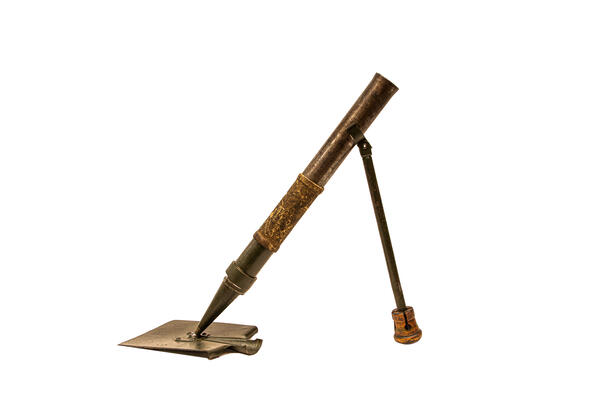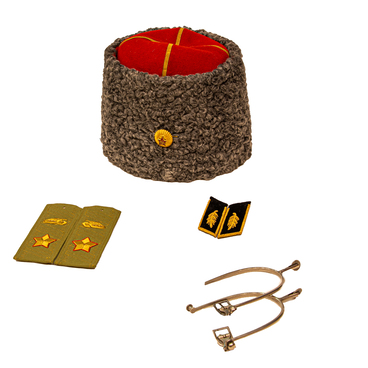The 37-millimeter Soviet mortar is a hybrid of a small sapper spade and a small-caliber mortar. The spade mortar was an experimental development of the Kolomna Plant. Its author was Mikhail Dyakonov, a Russian and Soviet designer of artillery ammunition and explosive devices.
The weapon consisted of a barrel, a spade, which also served as a baseplate, and a stand for firing with a stop — a bipod with a cork. The barrel tube was tightly connected to the breech block, the rear part where the bolt was located. The mortar was equipped by a cartridge case for 15 mines.
The mortar in the field position was a spade, with the barrel serving as its handle. The tool was used for various trench and earthworks as an ordinary small sapper spade.
The mortar itself weighed 1.5 kilograms.
To fire it, an original 37mm oscillating mine weighing around five hundred grams was developed. The range of such a mortar was about 250 meters.
Mortar spades were used during the Soviet-Finnish War of 1939-1940, where their low efficiency was revealed. Since they had no sighting devices, their accuracy was poor.
Since the mortar was aimed without sighting devices, the greatest range of the mine was at an angle of elevation of 45 degrees. It was not recommended to shoot at lower angles, to avoid frequent misfires. In addition, as the angle increased, the range of fire decreased. The angle of elevation was changed by repositioning the bipod, the device that supported the barrel in the firing position. To increase it, the bipod was leaned on the ground closer to the mortar; and to decrease it, the bipod was leaned further away from the gun. The angle was corrected after the results of the first shot: the angle had to be increased when the mine flew over, and, on the contrary, decreased when it did not.
The range of the mortar was short and the fragmentation effect of the 37 mm mine was weak: almost all the fragments simply were stuck in the snow. Because of this, the production of spade mortars was discontinued and the mines for them were removed from service. However, weapons of this type were sometimes used in the battles of the Great Patriotic War.
The weapon consisted of a barrel, a spade, which also served as a baseplate, and a stand for firing with a stop — a bipod with a cork. The barrel tube was tightly connected to the breech block, the rear part where the bolt was located. The mortar was equipped by a cartridge case for 15 mines.
The mortar in the field position was a spade, with the barrel serving as its handle. The tool was used for various trench and earthworks as an ordinary small sapper spade.
The mortar itself weighed 1.5 kilograms.
To fire it, an original 37mm oscillating mine weighing around five hundred grams was developed. The range of such a mortar was about 250 meters.
Mortar spades were used during the Soviet-Finnish War of 1939-1940, where their low efficiency was revealed. Since they had no sighting devices, their accuracy was poor.
Since the mortar was aimed without sighting devices, the greatest range of the mine was at an angle of elevation of 45 degrees. It was not recommended to shoot at lower angles, to avoid frequent misfires. In addition, as the angle increased, the range of fire decreased. The angle of elevation was changed by repositioning the bipod, the device that supported the barrel in the firing position. To increase it, the bipod was leaned on the ground closer to the mortar; and to decrease it, the bipod was leaned further away from the gun. The angle was corrected after the results of the first shot: the angle had to be increased when the mine flew over, and, on the contrary, decreased when it did not.
The range of the mortar was short and the fragmentation effect of the 37 mm mine was weak: almost all the fragments simply were stuck in the snow. Because of this, the production of spade mortars was discontinued and the mines for them were removed from service. However, weapons of this type were sometimes used in the battles of the Great Patriotic War.




